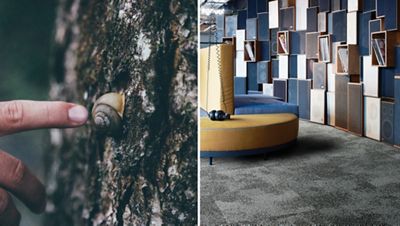We spend an estimated 11 hours a day on technology and up to 93% of our time indoors. And, 66% of the developed world will be urbanized by 2050. Now more than ever, harnessing Biophilia in the design of our urban living and working environments is vital to our health and well-being.
Breaking it down further, we know that there are individual elements of what constitutes biophilic design. Terrapin Bright Green used science and psychology to define those elements in their paper, ’14 Patterns of Biophilic Design.’ Their work helps us understand how to apply each point when considering human needs within design. Not every space can be designed to incorporate all the principles, but a few contributory Biophilic Design elements will collectively enhance the well-being of an interior.
The 14 patterns are grouped into three categories: Nature in the Space, Natural Analogues and Nature of the Space. Navigate below to learn more about each specific pattern and how it can be used within the built environment.
Nature in the Space | Natural Analogues | Nature of the Space
Nature in the Space
Individual perspective on what constitutes the ‘beauty of nature’ can vary. We have personal aesthetic experiences and reactions to elements of the natural world, but scientific research proves it is psychologically and physiologically fundamental for us to feel part of it on a regular basis. We need to connect to the natural environment.
Nature in the Spacetakes into account the parts of design that give us direct physical contact with nature from within an interior. That doesn’t mean proximity to a potted plant or two. Interaction with the natural world can be a stimulating view of nature, or it can be the presence of plants, water features, natural air-flow or breezes, sounds and scents. By working this group of patterns into our office or workplace design, we are bringing real elements of nature into our urban domain. It allows us to use all five senses to create an experiential space.
1. Visual Connection with Nature
Stimulating views to elements of nature, living systems and natural processes, such as a window with a garden or sea view, potted plants, flower beds, courtyard gardens, green walls and green roofs.
2. Non-Visual Connection with Nature
Often undervalued design interactions that stimulate our other senses of sound, touch, smell and taste to remind us of our connection to nature.
3. Non-Rhythmic Sensory Stimuli
The rich sensory stimuli of nature in consistent, yet unpredictable, motion, such as the gentle sway of grasses in a breeze or ripples on water.
4. Thermal & Airflow Variability
The subtle changes in air and surface temperature, humidity and airflow across the skin that mimic natural environments.
5. Presence of Water
To see, hear or touch it.
6. Dynamic & Diffuse Light
Clever use of light and shadow to mimic the lighting conditions or circadian processes occurring in nature.
7. Connection with Natural Systems
An awareness or proximity to natural processes, such as seasonal changes, reminding us of the process of healthy ecosystems.
(back to top)
Natural Analogues
Natural Analoguepatterns focus on the organic, non-living and implied elements of nature in a space. With these patterns, we use elements with an indirect connection to nature that create a cue to the brain that sparks the same sense of well-being as the natural world. Using the gentle, ordered or complex art of nature in design elements such as textile patterns, artwork, furniture and surfaces, can trigger our biophilic human link to nature and therefore inspire a rich or perhaps subtle or subconscious sense of well-being.
8. Biomorphic Forms & Patterns
Symbolic representations within the design of the patterns, shapes, textures or numerical arrangements found in nature.
9. Material Connection with Nature
Using materials, grains, textures and elements in design that distinctly reflect the natural environment to create an overarching sense of the natural world.
10. Complexity & Order
An abstract but visually appealing concept that uses the rich sensory information of the symmetries, hierarchies and geometries found in nature.
(back to top)
Nature of the Space
Nature of the Space patterns define how we relate to the building, room or space around us on a deeply human level. We have an innate desire to want to see beyond our immediate surroundings and can be fascinated with the slightly dangerous or unknown. Obscured views, design revelations, installations and moments of mystery or peril excite us and maintain our interest and enthusiasm.
11. Prospect
We have an intrinsic desire to see beyond our immediate surroundings or over long distances, dating back to an anthropological theory of survival. Prospect patterns consider a big-picture view of your environment. Elements of interior design that best represent this include the addition of balconies, oversized windows or skylights, mezzanine levels, open plan spaces or transparent partitions that provide uninterrupted views.
12. Refuge
Like Prospect, the Refuge pattern focuses on the ability to look out over your surroundings, but from the safety of a protected position away from the buzz of central areas of activity. An acoustic pod within an open-plan office, for example, provides a safe haven to concentrate away from noise or stimuliwhile maintaining a view of the world around it.
13. Mystery
Feel the excitement and unknown elements of the great outdoors in the built environment. The promise of more information, achieved through partially obstructed long-distance views, design revelations, surprising installations or unexpected architectural features, draws us in and engages us with our environment. The success of the Mystery pattern is in the anticipation of what might be around the corner, which creates a strong and undeniably pleasurable human response.
14. Risk/Peril
It’s the thrill of danger from an identifiable risk coupled with the sense of a reliable safeguard. Evolution designed us for survival. Whether it’s a high walkway or a glass wall overlooking a city skyline, the Risk/Peril pattern triggers the rush of living on the edge of safety.









